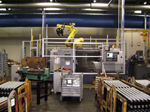In its latest report, Gardner Business Media reports that the metalworking industry grew in January for the first time since March 2015 with the Gardner Business Index reaching 53.8.
In its latest report, Gardner Business Media reports that the metalworking industry grew in January for the first time since March 2015 with the Gardner Business Index reaching 53.8.
Additive manufacturing, AKA 3-D printing, is clearly becoming more viable in certain production situations. However, additive cannot replace conventional machining in all applications. In fact, the best way to harness the efficiencies of additive today may be to combine it with subtractive manufacturing. In this way, you gain the advantages of both technologies without being restricted to the limits of either method.
A recently released survey conducted by the Association For Manufacturing Technology (AMT – the folks who bring us IMTS every other year) identifies three major trends that have enormous impact on how OEMs, distributors, integrators and end users will function in the future.
 According to survey data released by Gardner Business Media, American manufacturers have rebounded from the Great Recession. In fact, the Index of Durable Goods showed that production of durable goods is at an all-time high.
According to survey data released by Gardner Business Media, American manufacturers have rebounded from the Great Recession. In fact, the Index of Durable Goods showed that production of durable goods is at an all-time high.
 For many years advances in metalworking manufacturing technology centered on increasing throughput and reducing cycle times through faster spindle speeds and feed rates, improved tooling, and the emergence of multi-function CNC machining centers. Today, these factors are taken for granted as ongoing improvements in machine tool performance are expected. The current trends in technology focus less on the machine tools themselves, and more on other aspects of the manufacturing process. Here are some of the more prominent trends we see:
For many years advances in metalworking manufacturing technology centered on increasing throughput and reducing cycle times through faster spindle speeds and feed rates, improved tooling, and the emergence of multi-function CNC machining centers. Today, these factors are taken for granted as ongoing improvements in machine tool performance are expected. The current trends in technology focus less on the machine tools themselves, and more on other aspects of the manufacturing process. Here are some of the more prominent trends we see:
 For many years all aspects of business have been under intense pressure to drive down costs so we can be more competitive and profitable. Perhaps nowhere is this pressure more intense than in manufacturing. Of course, there are a number of ways to reduce production costs, and you have most likely addressed many of them. Even so, it’s always a good idea to take a fresh look at your operation to see if you’ve overlooked anything.
For many years all aspects of business have been under intense pressure to drive down costs so we can be more competitive and profitable. Perhaps nowhere is this pressure more intense than in manufacturing. Of course, there are a number of ways to reduce production costs, and you have most likely addressed many of them. Even so, it’s always a good idea to take a fresh look at your operation to see if you’ve overlooked anything.
 There’s been a great deal of talk about American jobs that were lost when U.S. companies located manufacturing facilities in China, Mexico, and elsewhere to take advantage of cheap labor. Recently, however, several of these companies have announced that they are brining their manufacturing back to the United States. In fact, as reported in Industry Week Magazine, a recent study by the Boston Consulting Group (BCG) concludes that 37% of large, U.S. manufacturers they surveyed plan to reshore manufacturing. Another study of 319 companies by the Council of Supply Chain Management Professionals put the reshoring figure at 38%.
There’s been a great deal of talk about American jobs that were lost when U.S. companies located manufacturing facilities in China, Mexico, and elsewhere to take advantage of cheap labor. Recently, however, several of these companies have announced that they are brining their manufacturing back to the United States. In fact, as reported in Industry Week Magazine, a recent study by the Boston Consulting Group (BCG) concludes that 37% of large, U.S. manufacturers they surveyed plan to reshore manufacturing. Another study of 319 companies by the Council of Supply Chain Management Professionals put the reshoring figure at 38%.